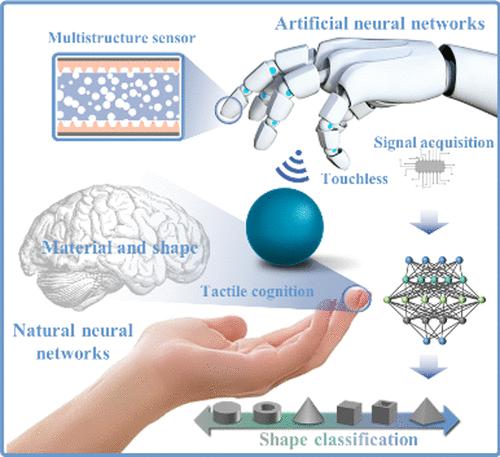Our official English website, www.x-mol.net, welcomes your feedback! (Note: you will need to create a separate account there.)
Bimodal Intelligent Electronic Skin Based on Proximity and Tactile Interaction for Pressure and Configuration Perception
ACS Sensors ( IF 8.9 ) Pub Date : 2024-03-19 , DOI: 10.1021/acssensors.4c00136 Qirui Wu 1, 2 , Chunhui Zhou 2 , Yidan Xu 3 , Songjiu Han 1, 2 , Anbang Chen 1 , Jiayu Zhang 1 , Yujia Chen 1 , Xiaoxiang Yang 2 , Jianren Huang 1 , Lunhui Guan 1
ACS Sensors ( IF 8.9 ) Pub Date : 2024-03-19 , DOI: 10.1021/acssensors.4c00136 Qirui Wu 1, 2 , Chunhui Zhou 2 , Yidan Xu 3 , Songjiu Han 1, 2 , Anbang Chen 1 , Jiayu Zhang 1 , Yujia Chen 1 , Xiaoxiang Yang 2 , Jianren Huang 1 , Lunhui Guan 1
Affiliation

|
The flexible bimodal e-skin exhibits significant promise for integration into the next iteration of human–computer interactions, owing to the integration of tactile and proximity perception. However, those challenges, such as low tactile sensitivity, complex fabrication processes, and incompatibility with bimodal interactions, have restricted the widespread adoption of bimodal e-skin. Herein, a bimodal capacitive e-skin capable of simultaneous tactile and proximity sensing has been developed. The entire process eliminates intricate fabrication techniques, employing DLP-3D printing for the electrode layers and sacrificial templating for the dielectric layers, conferring high tactile sensitivity (1.672 kPa–1) and rapid response capability (∼30 ms) to the bimodal e-skin. Moreover, exploiting the “fringing electric field” effect inherent in parallel-plate capacitors has facilitated touchless sensing, thereby enabling static distance recognition and dynamic gesture recognition of varying materials. Interestingly, an e-skin sensing array was created to identify the positions and pressure levels of various objects of different masses. Furthermore, with the aid of machine learning techniques, an artificial neural network has been established to possess intelligent object recognition capabilities, facilitating the identification, classification, and training of various object configurations. The advantages of the bimodal e-skin render it highly promising for extensive applications in the field of next-generation human–machine interaction.
中文翻译:

基于接近和触觉交互的双模智能电子皮肤,用于压力和配置感知
由于触觉和接近感知的集成,灵活的双模电子皮肤在集成到下一代人机交互中展现出巨大的前景。然而,这些挑战,例如低触觉灵敏度、复杂的制造工艺以及与双模相互作用的不兼容,限制了双模电子皮肤的广泛采用。在此,开发了一种能够同时进行触觉和接近感测的双模电容式电子皮肤。整个过程消除了复杂的制造技术,对电极层采用 DLP-3D 打印,对介电层采用牺牲模板,赋予双峰电子皮肤高触觉灵敏度 (1.672 kPa –1 ) 和快速响应能力 (∼30 ms) 。此外,利用平行板电容器固有的“边缘电场”效应促进了非接触式传感,从而实现了不同材料的静态距离识别和动态手势识别。有趣的是,创建了电子皮肤传感阵列来识别不同质量的各种物体的位置和压力水平。此外,借助机器学习技术,建立了人工神经网络,具有智能对象识别能力,有助于对各种对象配置进行识别、分类和训练。双模电子皮肤的优点使其在下一代人机交互领域具有广泛的应用前景。
更新日期:2024-03-20
中文翻译:

基于接近和触觉交互的双模智能电子皮肤,用于压力和配置感知
由于触觉和接近感知的集成,灵活的双模电子皮肤在集成到下一代人机交互中展现出巨大的前景。然而,这些挑战,例如低触觉灵敏度、复杂的制造工艺以及与双模相互作用的不兼容,限制了双模电子皮肤的广泛采用。在此,开发了一种能够同时进行触觉和接近感测的双模电容式电子皮肤。整个过程消除了复杂的制造技术,对电极层采用 DLP-3D 打印,对介电层采用牺牲模板,赋予双峰电子皮肤高触觉灵敏度 (1.672 kPa –1 ) 和快速响应能力 (∼30 ms) 。此外,利用平行板电容器固有的“边缘电场”效应促进了非接触式传感,从而实现了不同材料的静态距离识别和动态手势识别。有趣的是,创建了电子皮肤传感阵列来识别不同质量的各种物体的位置和压力水平。此外,借助机器学习技术,建立了人工神经网络,具有智能对象识别能力,有助于对各种对象配置进行识别、分类和训练。双模电子皮肤的优点使其在下一代人机交互领域具有广泛的应用前景。



























 京公网安备 11010802027423号
京公网安备 11010802027423号